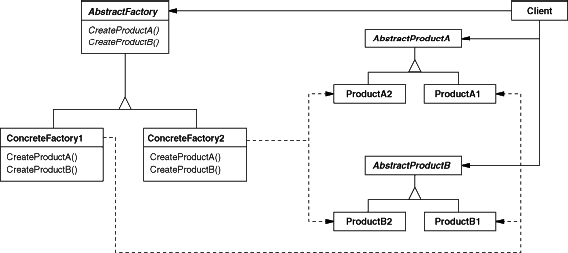Design Pattern ->Abstract Factory
Layering & Contract Philosophy With additional indirection
Abstract Factory

//The example code is as following:
class CAbstractProductA;
class CAbstractProductB;
// multiple families of products.
class CProductA1:public CAbstractProductA;
class CProductB1:public CAbstractProductB;
class CProductA2:public CAbstractProductA;
class CProductB2:public CAbstractProductB; class CAbstractFactory
{
public:
virtual CAbstractProductA* CreateProductA() = ;
virtual CAbstractProductA* CreateProductB() = ;
};
class CConreateFactory1:public CAbstractFactory; //indirection layer
{
public:
virtual CAbstractProductA* CreateProductA() { return new CProductA1; }
virtual CAbstractProductB* CreateProductB() { return new CProductB1; }
}
class CConreateFactory2:public CAbstractFactory;//indirection layer
{
public:
virtual CAbstractProductA* CreateProductA() { return new CProductA2; }
virtual CAbstractProductB* CreateProductB() { return new CProductB2; }
} class CClient
{
public:
CAbstractFactory *pFactory = NULL;
void main()
{
if ( the system is windows )
{
pFactory = new CConreateFactory1();
}
else
{
pFactory = new CConreateFactory2();
}
CAbstractProductA *pProductA = pFactory->CreateProductA();
CAbstractProductB *pProductB = pFactory->CreateProductB();
}
};
Applicability
Use the Abstract Factory pattern when:
- A system should be independent of how its products are created, compose /decompose, and represented.
- A system should be configured with one of multiple families of products.
- A family of related product objects is designed to be used together, and you need to enforce this constraint.
- You want to provide a class library of products, and you want to reveal just their interfaces, not their implementations. Interface-Oriented programming, Open For Extension, Close For Change,These All is said to Users or Client. Users don’t care or never know what is changed, so called “Close For Change”.
- You want to create a set of product without changing client code. Just create a new pointer to the object instantiated with class derived from base class AbstractClass.
Participants
- AbstractFactory (WidgetFactory): declares an interface for operations that create abstract product objects.
- ConcreteFactory (MotifWidgetFactory, PMWidgetFactory):implements the operations to create concrete product objects.
- AbstractProduct (Window, ScrollBar):declares an interface for a type of product object.
- ConcreteProduct (MotifWindow, MotifScrollBar): concrete / specific defines a product object to be created by the corresponding concrete factory,implements the AbstractProduct interface.
- Client: uses only interfaces declared by AbstractFactory and AbstractProduct classes.
Collaborations
- Normally a single instance of a ConcreteFactory class is created at run-time.This concrete factory creates product objects having a particular implementation. To create different product objects, clients should use a different concrete factory.The Client get the a pointer or reference from the Singleton object created with ConcreteFactory at run-time.
- AbstractFactory defers creation of product objects to its ConcreteFactory subclass.
From:Design Patterns:Elements of Reusable Object-Oriented Software, by GoF
Design Pattern ->Abstract Factory的更多相关文章
- LN : Eden Polymorphic And OOP Design Pattern Abstract Factory
Appreciation to our TA, +7, who designed this task. Client.cpp #include <iostream> #include &l ...
- [design pattern](5) Factory Method
前言 在前面一章博主介绍了简单工厂模式(Simple Factory),接着上面的章节,今天博主就来介绍下工厂方法模式(Factory Method). 思考题 首先,让我们来思考下面的问题: 在上一 ...
- 简单工厂设计模式(Simple Factory Design Pattern)
[引言]最近在Youtub上面看到一个讲解.net设计模式的视频,其中作者的一个理解让我印象很深刻:所谓的设计模式其实就是运用面向对象编程的思想来解决平时代码中的紧耦合,低扩展的问题.另外一点比较有见 ...
- [转]Design Pattern Interview Questions - Part 1
Factory, Abstract factory, prototype pattern (B) What are design patterns? (A) Can you explain facto ...
- Design Pattern ——Factory Method&Abstract Factory
今天开始复习设计模式.设计模式相关的资料有很多,概念性的东西就画个图就可以了.把关注点放在例子上,设计模式还是要使用中才有感受. 从Factory Method&Abstract Factor ...
- 大白话抽象工厂模式(Abstract Factory Pattern)
实例分析 大白话工厂方法模式(Factory Method)一文中,我们讲解了日产4S店工厂规模的扩大,创建了针对不同车型的工厂,减少了工厂的工作内容,提高了效率.下面我们继续以4S店的故事讨论抽象工 ...
- Net设计模式实例之抽象工厂模式(Abstract Factory Pattern)
一.抽象工厂模式简介(Bref Introduction) 抽象工厂模式(Abstract Factory Pattern),提供一个创建一系列相关或者相互依赖对象的接口,而无需制定他们的具体类.优点 ...
- [Design Pattern] Factory Pattern 简单案例
Factory Pattern , 即工厂模式,用于创建对象的场景,属于创建类的设计模式 . 下面是一个工厂模式案例. Shape 作为接口, Circle, Square, Rectangle 作为 ...
- design pattern factory method #Reprinted#
引入人.工厂.和斧子的问题: (1),原始社会时,劳动社会基本没有分工,需要斧子的人(调用者)只好自己去磨一把斧子,每个人拥有自己的斧子,如果把大家的石斧改为铁斧,需要每个人都要学会磨铁斧的本领,工作 ...
随机推荐
- P3348 [ZJOI2016]大森林
\(\color{#0066ff}{ 题目描述 }\) 小Y家里有一个大森林,里面有n棵树,编号从1到n.一开始这些树都只是树苗,只有一个节点,标号为1.这些树都有一个特殊的节点,我们称之为生长节点, ...
- POJ1511 Invitation Cards SPFA算法裸题变形
原题目:http://poj.org/problem?id=1511 给出一个有向图,求出这个图从1到所有点的最短路径和所有点到1的最短路径的和. 这题数据量有点大,数据范围也大,所以用SPFA+邻接 ...
- 14.Diameter of Binary Tree(二叉树的直径)
Level: Easy 题目描述: Given a binary tree, you need to compute the length of the diameter of the tree. ...
- UICollectionView的基本使用 collectionView
#pragma mark -- 创建CollectionView - (void)createCollectionView{ //关闭自适应 self.automaticallyAdjustsScro ...
- python中各种转义字符
转义字符 描述 \(在行尾时) 续行符 \\ 反斜杠符号 \’ 单引号 \” 双引号 \a 响铃 \b 退格(Backspace) \e 转义 \000 空 \n 换行 \v 纵向制表符 \t 横向制 ...
- Experimental Educational Round: VolBIT Formulas Blitz D
Description After a probationary period in the game development company of IT City Petya was include ...
- Experimental Educational Round: VolBIT Formulas Blitz B
Description The city administration of IT City decided to fix up a symbol of scientific and technica ...
- Go语言基础之21--反射
一.变量介绍 1.1 变量的内在机制 A. 类型信息,这部分是元信息,是预先定义好的:比如:string.int等 B. 值类型,这部分是程序运行过程中,动态改变的:比如:是变量实例所存储的真是的值. ...
- PHP HTTP的PUT,DELETE的使用
GET操作是安全的.所谓安全是指不管进行多少次操作,资源的状态都不会改变.比如我用GET浏览文章,不管 浏览多少次,那篇文章还在那,没有变化.当然,你可能说每浏览一次文章,文章的浏览数就加一,这不也改 ...
- IHttpAsyncHandler IHttpHandler
1.建立 .ashx 文件 2.异步HTTPHandler的实现https://www.cnblogs.com/HQFZ/p/5688759.html 3.Asp.net异步IHttpAsyncHan ...
